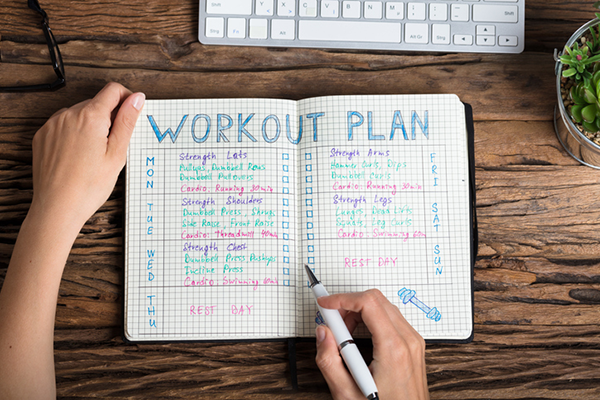Physical Address
304 North Cardinal St.
Dorchester Center, MA 02124
Physical Address
304 North Cardinal St.
Dorchester Center, MA 02124

The most difficult part of the exercise is not usually the exercise itself. It is knowing how to start. It can be intimidating to discover what to do, how long and how often. Creating a safe and effective exercise routine that you can really follow requires some strategy. Enter: The adjustment principle.
Also known as the FITT formula, this is a set of simple guidelines that can be followed to design a training program designed for your goals, Physical experienceand lifestyle.
The adjustment principle represents frequency, intensity, timeand guywhich are key variables that you can adjust to help you get the results you want from training, all in a timely manner with a limited risk of burned or hurt.
“These variables work together to match their total workload,” says Cody Braun, CSCS. Learning to effectively modify the four components of the adjustment principle can help you establish and achieve objectives of achieveable physical conditioning and prevent injuries, he explains.
Here is a deeper immersion in how each part of the formula works to create the best training program for you.

The frequency simply refers to the number of days in its training routine, and is the basis of its training program. “This is where you design the design of when to train Each muscle group And when you take rest days“Braun says.
Do you want to make a five -day routine or can you only commit to three days?
Its training frequency will ultimately depend on its schedule and objectives, but the American College of Sports Medicine (ACSM) recommends a minimum of Three days a week.

Intensity is an indicator of how hard it is working, in other words, whether it is happening through training or barely enduring.
When you try to discover at what level of intensity you should point, one thing to consider are your goals. If you want to set fire and develop muscle, High intensity intervals training (HIIT) It can be a great option.
If you like Improve your cardiovascular resistanceresort to moderate intensity steady state activities like run and cycling. It all depends on what you strive to achieve.
A second aspect to consider is your physical condition level. For example, if you are new in the physical state, an HIIT training could be too much and get too tired or painful the next day. Being too beaten from your previous training can be discouraging, and could lead him to give up his program. It can also cause injuries if your body is not ready for that level of intensity.
It is good to start with training that are not so rigorous at the beginning. Then, as it begins to improve its physical condition level, it can increase the intensity little by little.
To evaluate intensity, Mike DonavanikCSCS, he says you can use perceived effort rate (RPE) To determine how much effort you are making. Based on you Maximum heart rate In a training, the RPE scale allows you to associate a number with the intensity of the training. The lower the number, the easier the training will be.
Another option to measure the intensity of training is the “conversation test.” If you can barely murmur a word while exercising, then it is likely to reach its maximum intensity. But if you can easily maintain a conversation, then the training is on the lighter side of the scale.

This part of the acronym Fitt refers to the duration of each training session. Are you cracking on time and you can only put 20 minutes training? Or do you have the leisure of spending a full hour in the gym?
Regardless of the duration of the training you choose, keep in mind that there is an inverse relationship between time and intensity during exercise, says Braun. “When the intensity is greater, the (time) will be lower and vice versa,” he explains.
That means that you can still make those 20 -minute routines work as well as the longest: intensity should only be with all your strength. If you want to follow the ACSM recommendationThey suggest doing five days of moderate intensity exercise per week to total a minimum of 150 minutes, or three days a week of high intensity exercise to total a minimum of 75 minutes.

The guy refers to the specific training activity: executing, weightliftingKickboxing, etc. “Not all training are the same,” says Braun, so it is important to choose the exercise that will drive it towards its objectives.
If you want to run a marathon, you must concentrate on activities that Improve your cardiovascular resistance. You may want something that is soft in your joints, so you opt for a low -impact activity How to swim.
Or maybe you want to lose fat. For this goal, Braun suggests focusing on training that burn calories and build muscle, as a healthy combination of cardio and Resistance training.
Whether you are creating a training plan yourself or trying to Choose between training programs They have already been designed, the Fiit principle can help make the overwhelming process of putting in shape more manageable.
By dividing the process into four parts, “it allows you to have a better idea of how your training routine looks, how can you modify it Fulfill your goalsor where certain activities are missing, ”says Donavanik.
When a program begins, see yourself every two weeks to evaluate your progress and see how you feel. “If you start noticing a plateauIt’s probably time to change one of the variables, ”says Braun.
Changing only one or two variables every six to eight weeks gives you time to dominate a routine while maintaining progress.
“For example: frequency, time and type could remain the same, but you may want to increase the intensity of your training, which can be heavier weights, more repetitions or faster execution speeds,” Donavanik explains.
On the other hand, if you feel perpetually sore or fatigued, Braun recommends reducing a variable to avoid injury and exhaustion. This could happen, for example, if you are exercising five days a week at maximum intensity for 50 minutes.
In this case, you can return to four days of exercise and evaluate how you feel then. Or maybe it remains in the same number of days, but shorten each training in 15 minutes.
By adjusting the components of the FITT principle, you can adjust a program to meet your needs and achieve your objectives efficiently without hurting.
Fighting to build a training routine? Leave the programming to experts and try one from Bodi training programsthat differ in the duration of the program, the duration of training, intensity and the type of exercise. From weightlifting and Hiit to Barre and Yoga, we provide dozens of programs that can adjust to their unique goals and preferences.